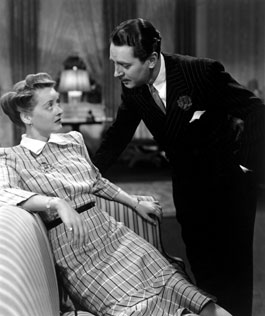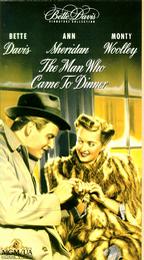FILM NOTES
FILM NOTES INDEX
NYS WRITERS INSTITUTE
HOME PAGE

Directed by William Keighley
(United States, 1942, 112 minutes, b&w, 16mm)
Starring:
Bette Davis……….Maggie Cutler
Ann Sheridan……….Lorraine Sheldon
Monty Woolley……….Sheridan Whiteside
Richard Travis……….Bertram H. 'Bert' Jefferson
The
following film notes were prepared for the New York State Writers
Institute by Kevin Jack Hagopian, Senior Lecturer in Media Studies
at Pennsylvania State University:
When The Man Who Came to Dinner went before the cameras in the summer of 1941, the Hollywood Golden Age motion picture studio was one of the most remarkable culture factories since the Renaissance studios of Titian and Tintoretto. And Warner Bros, in Burbank, was one of the most efficient of those factories.
George S. Kaufman and Moss Hart's Broadway smash The Man Who Came to Dinner was one of hundreds of plays and novels read, seen, and reported on by the studio's readers in Hollywood and New York. Once Kaufman and Hart were induced to part with the screen rights (for a percentage of the profits, instead of the $300,000 they were asking), the film was turned over to executive producer Hal Wallis for development as one of the studio's big-budget productions of its year; Warner Bros theater owners around the country were alerted up to a year in advance that the film was in production. (What they weren't alerted to, but which they would have known, is that to get a guaranteed hit like The Man Who Came to Dinner, they'd have to take B-films like that year's more forgettable Warner Bros epics, Lady Gangster, Spy Train, and Busses Roar.)
Several writers worked on the script, but work on the final version moved forward with the greatest script doctors in Hollywood, the magnificent Epstein brothers, Julius and Philip, a year away from beginning work with Wallis on Casablanca. Meanwhile, the astute Wallis talked to several directors under contract to Warner Bros It's certain he would have talked to the studio's workhorse, Michael Curtiz, who directed two others that year, and three the next, including Casablanca and Yankee Doodle Dandy. But the most intriguing possibility was Howard Hawks, fresh from Sergeant York, and who would go on to make To Have and Have Not at the studio. Hawks wanted to star Cary Grant in the film. Finally, William Keighley, a versatile, Curtiz-like craftsman, was chosen.
 The Man Who Came to Dinner had Hal Wallis, a hands-on producer who by this time had personal control over a slate of prestige releases to cast actors from the studio's talent roster to the film. They ranged from stars (Bette Davis campaigned heavily for the role of Maggie Cutler, after non-Warners actors Myrna Loy and Jean Arthur were considered) to bits (that's Warners stalwart John Ridgely as "the radio man"). For featured roles, the studio's list of contract players was scanned. The second male lead for instance, small town journalist Burt Jefferson, went to Richard Travis. It was exactly the sort of patented role that could vault a young, handsome actor like Travis to stardom; it didn't, and he spent the next several years languishing in lesser Warners films. (One of the actors also considered for the potentially star-making role was Warner Bros veteran Ronald Reagan; the next year, he'd get his chance, Warners' King's Row.)
The Man Who Came to Dinner had Hal Wallis, a hands-on producer who by this time had personal control over a slate of prestige releases to cast actors from the studio's talent roster to the film. They ranged from stars (Bette Davis campaigned heavily for the role of Maggie Cutler, after non-Warners actors Myrna Loy and Jean Arthur were considered) to bits (that's Warners stalwart John Ridgely as "the radio man"). For featured roles, the studio's list of contract players was scanned. The second male lead for instance, small town journalist Burt Jefferson, went to Richard Travis. It was exactly the sort of patented role that could vault a young, handsome actor like Travis to stardom; it didn't, and he spent the next several years languishing in lesser Warners films. (One of the actors also considered for the potentially star-making role was Warner Bros veteran Ronald Reagan; the next year, he'd get his chance, Warners' King's Row.)
Casting the plum role of Sheridan Whiteside proved to be difficult. Frederic March, Charles Laughton, and Robert Benchley were all considered, and rejected. Davis wanted John Barrymore; there's some evidence that Barrymore worked on the film, but by then, his alcoholism made it impossible for him to remember the many lines his part required. Finally, Monty Woolley, the star of the Broadway version of the play was deemed a safe choice; Woolley turned out be a hit with audiences, and went on to unique starring roles, most of them variations on his curmudgeonly Whiteside persona, into the 1950's.
Production went on; the film began shooting in July 1941. Production was luxuriously long for a Warner Bros film; the film didn't wrap until mid-October, 1941, after production had been shut down for some time due to what was described as an injury to Bette Davis' nose --- more likely, one of the endless disputes between Davis and the Warner Bros over creative issues on this or another film. The efficiencies of scale of the old motion picture studios are hard to imagine today. The Man Who Came to Dinner was of 35 features Warners released in 1942, including Yankee Doodle Dandy and Now, Voyager, along with dozens of shorts, newsreels, and trailers. Production at this level required immense resources. The Man Who Came to Dinner's art director, Robert Haas, for instance, could have relied on a full-blown research department to help him portray the house of the harassed Middle West burger Ernest Stanley. Haas also had a staff of experienced set carpenters to build it the house, and a huge props department to furnish it. Most of the action takes place in the Stanley house, so for the home's interior first floor, Haas designed one of the complex "unit sets" Warners was noted for. (The most legendary was the Rick's Café Americain set for Casablanca.) Standing sets around the Warners lot, and short hops to familiar locations in the Los Angeles area would fill in the rest. The house exterior was probably constructed on one of Warners' several street sets, probably the "suburban street" set. The film's railroad station would be familiar to viewers from other films, like 1942's King's Row and The Hard Way. Indeed, the "look" of a film like The Man Who Came to Dinner was less the product of a director than of a director of photography (like The Man Who Came to Dinner's ace cinematographer, Tony Gaudio), and the art directors and composers who worked so frequently for a studio that their imprint became that of the studio. After shooting, the film went on to editing and previewing, while the creative personnel went on to other things. Davis was to do three films in 1942, while director Keighley immediately went to another adaptation of a theatrical property, George Washington Slept Here, a film which almost certainly used the Stanley family house set, redressed as a dilapidated farmhouse made over into a handsome country home
When The Man Who Came to Dinner was released in January, 1942, Warner Bros had both a distribution system and a major theater chain. Most of the Warner Bros 425 houses were in desirable urban locations, Warner Bros was particularly strong in Pennsylvania, New Jersey, Maryland, and D.C., and the film almost certainly played one of the Warner Bros houses in the Albany area. Warners also had substantial interests in British theaters, and distribution to 27 other countries, but the war had severely curtailed European and Far East markets, which may account for the increase in Americana like The Man Who Came to Dinner, Kings Row, The Male Animal, and One Foot in Heaven in Warner Bros production plans for 1941-1942. The Man Who Came To Dinner was one of a successful year of releases that would enable Warners to record 8.6 million in profits for 1942, the studio's strongest year to date.
In a few years, it would be over. Attendance at the movies would peak in 1946, at more than 90,000,000 attendances per week, but television, growing families, and the exodus to the suburbs would all conspire to make the motion picture studio of the classical Hollywood period a dinosaur. By the 1947-1948 production season, the studios were already laying off contract players, and even stars became expendable. Bette Davis, the woman they had once called "the fourth Warner Brother," left the studio in 1949, her contract unrenewed. That year, the "Paramount decrees" of 1949 broke up what was left, forcing the studios to comply with anti-trust statutes by selling off their theaters and their production plants in Hollywood, leaving them as the distribution entities we know today.
The great culture machine known as the Hollywood motion picture studio is no more, but, like traces in a cloud chamber, films like The Man Who Came to Dinner, witty, human, and hugely entertaining, remain to speak of a consistent richness of craft and a professionalism whose like we shall never see again.
— Kevin Hagopian, Penn State University
For additional information, contact the Writers Institute at 518-442-5620 or online at https://www.albany.edu/writers-inst.
 The Man Who Came to Dinner
The Man Who Came to Dinner